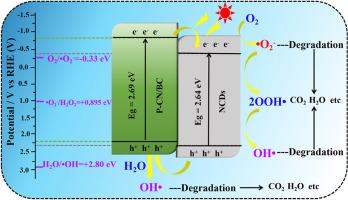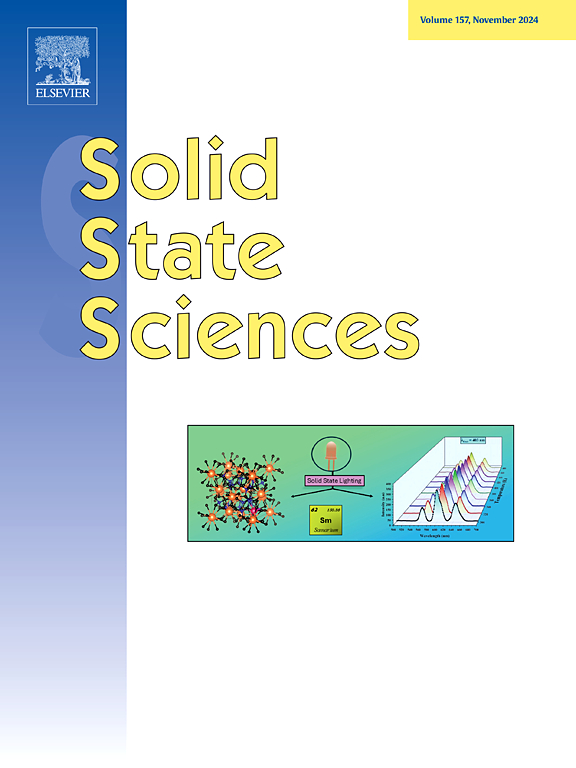一种新型无金属纳米材料 P-CN/BC/NCDs 的制备及其光催化降解性能
IF 3.4
3区 化学
Q2 CHEMISTRY, INORGANIC & NUCLEAR
引用次数: 0
摘要
开发具有高电荷分离和迁移效率的光催化剂以利用阳光进行环境修复一直是研究的重点。本研究采用热凝结法和水热法成功合成了氮化石墨碳(P-CN)、生物炭(BC)和掺氮碳量子点(NCDs)三元复合光催化剂 P-CN/BC/NCDs。选择茜素红 S(ARS)作为模型污染物来评估其光催化降解性能。在可见光照射下,P-CN/BC/NCDs 表现出更强的光催化降解性能,与单独的 P-CN 相比提高了 4.5 倍。最佳的 NCDs 负载 P-CN/BC 纳米复合材料具有高可见光吸收率和高比表面积。光电流强度的增加以及荧光强度和电阻的降低进一步证实了光催化活性的提高。XPS 和 FT-IR 测试表明,NCD 作为 P-CN/BC 的辅助催化剂,通过醚键和静电作用有效地促进了电荷分离。自由基捕获实验和 EPR 测试验证了 -O2- 是光催化过程中的主要活性物种,而 -OH 则是降解过程中的辅助位点。循环实验表明,这种催化剂具有很高的重复利用率和出色的稳定性,活性超过 93.8%。通过液质分析确定了分解中间产物和反应途径。在类似条件下,使用甲基橙(MO)、罗丹明 B(Rh B)等不同污染物评估了光催化剂的普适性。这种对 P-CN 材料进行功能协同改性的设计理念有望应用于各个领域。本文章由计算机程序翻译,如有差异,请以英文原文为准。

A novel metal-free nanomaterial P-CN/BC/NCDs preparation and its performance of photocatalytic degradation
The development of photocatalysts with high charge separation and migration efficiencies for environmental remediation using sunlight had been a research priority. In this study, a ternary composite photocatalyst, P-CN/BC/NCDs, was successfully synthesized by thermal condensation and hydrothermal methods, incorporating graphitic carbon nitride (P-CN), biochar (BC), and nitrogen-doped carbon quantum dots (NCDs). Alizarin red S (ARS) was selected as the model pollutant to evaluate the photocatalytic degradation performance. P-CN/BC/NCDs exhibited enhanced photocatalytic degradation performance under visible light irradiation, with a 4.5-fold improvement compared to P-CN alone. The optimally NCDs-loaded P-CN/BC nanocomposites exhibited high visible light absorption and high specific surface area. The increased photocatalytic activity was further confirmed by the increase in photocurrent intensity and the decrease in fluorescence intensity and resistance. XPS and FT-IR tests showed that NCDs, as co-catalysts of P-CN/BC, effectively promoted charge separation through ether bonds and electrostatic interactions. It was experimentally verified by free radical trapping experiments and EPR tests that •O2− was the primary active species in the photocatalytic process, while •OH served as an auxiliary site during the degradation process. Cyclic experiments demonstrated high reusability and excellent stability, with an activity exceeding 93.8 %. Decomposition intermediates and reaction pathways were identified by liquid-quality analysis. Photocatalyst pervasiveness was evaluated by using different pollutants including methyl orange (MO), rhodamine B (Rh B) under similar conditions. This design concept of functional synergistic modification of P-CN materials holds promise for application in various fields.
求助全文
通过发布文献求助,成功后即可免费获取论文全文。
去求助
来源期刊

Solid State Sciences
化学-无机化学与核化学
CiteScore
6.60
自引率
2.90%
发文量
214
审稿时长
27 days
期刊介绍:
Solid State Sciences is the journal for researchers from the broad solid state chemistry and physics community. It publishes key articles on all aspects of solid state synthesis, structure-property relationships, theory and functionalities, in relation with experiments.
Key topics for stand-alone papers and special issues:
-Novel ways of synthesis, inorganic functional materials, including porous and glassy materials, hybrid organic-inorganic compounds and nanomaterials
-Physical properties, emphasizing but not limited to the electrical, magnetical and optical features
-Materials related to information technology and energy and environmental sciences.
The journal publishes feature articles from experts in the field upon invitation.
Solid State Sciences - your gateway to energy-related materials.
 求助内容:
求助内容: 应助结果提醒方式:
应助结果提醒方式:


